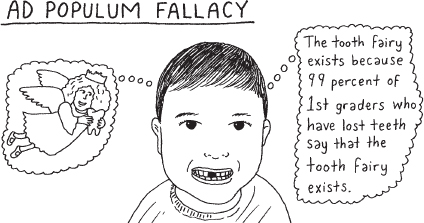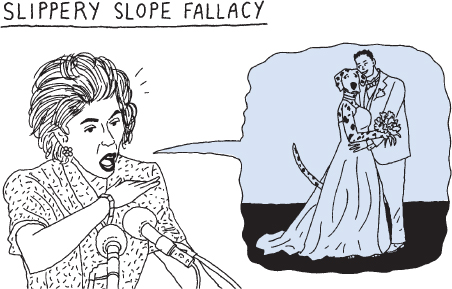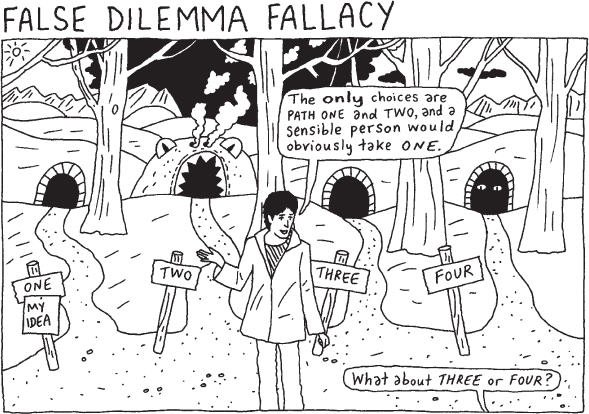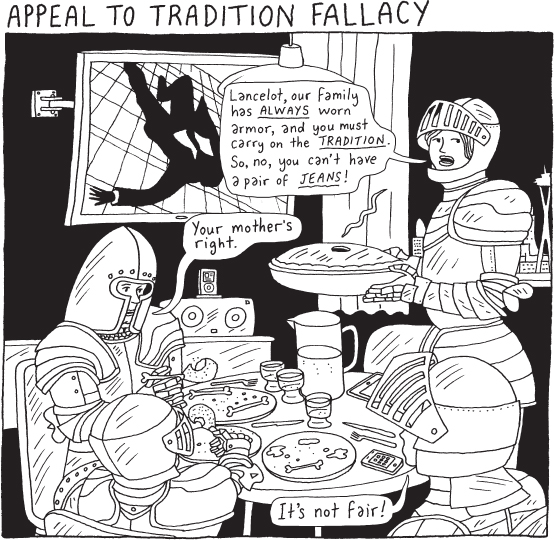Avoiding Logical Fallacies
Printed Page 562
Reasoning is fallacious (faulty) when the link between your claim and supporting material is weak. We briefly mentioned several fallacies in chapter 3 in the context of unethical persuasion: hasty generalization, post hoc fallacy, ad hominem (personal attack), and ad populum (bandwagon). Here, we explain the logical error in some of these fallacies and highlight other oft-committed fallacies that you’ll want to avoid in your speeches.
Hasty Generalization. When using example reasoning, be sure to avoid hasty generalization. This fallacy occurs when a speaker bases a conclusion on limited or unrepresentative examples. For example, it would be fallacious to reason that jobs could be created in any city whose leaders put their mind to it based on the example of Austin, Texas. Austin has a number of unique job-creation advantages that other cities may not be able to match—it is the home of a first-rate university, a highly educated population, the state capitol, and a robust venture capital scene.14

Causal Reasoning Errors. One common error in causal reasoning is the post hoc fallacy. The fallacy lies in the assumption that just because one event followed another, the first event caused the second. But this sequence of events, in itself, does not prove causality. For example, suppose a college expanded the size of its library, and students’ grades subsequently increased. It might be tempting to conclude that the expansion of the library caused the improvement in grades. However, there might be other factors that led to the higher grades—rising admission standards, increased student motivation to achieve, or grade inflation. Before you could confidently claim that library expansion was the cause of the higher grades, other likely factors would need to be ruled out.

It’s also important to watch out for reversed causality, in which speakers miss the fact that the effect is actually the cause. For example, an improvement in the academic quality of the student body may have led to the college’s expansion of the library to accommodate the study habits of these highly motivated students.
Ad Populum (Bandwagon) Fallacy. You’ve committed the ad populum (bandwagon) fallacy if you assume that a statement (“The earth is ten thousand years old,” “Young people are less politically active today than they were fifty years ago,” “Gun control would reduce the murder rate”) is true or false simply because a large number of people say it is.

The problem with basing the truth of a statement on the number of people who believe it is that most people have neither the expertise nor the time to conduct the research needed to arrive at an informed opinion about the big questions of the day. For this reason, it’s best to avoid using public-opinion polls to prove facts.

Ad Hominem (Personal Attack) Fallacy. Some speakers try to compensate for weak arguments by making personal attacks against an opponent rather than addressing the issue in question. These attacks are called ad hominem attacks, taken from the Latin “to the person.” For example, in a campaign speech for student body president, one candidate referred to her rival as a “tree hugging environmental whack job.” Her goal? To stir up listeners’ bias against outspoken environmentalists on campus and thus persuade them to reject the other candidate as an extremist. This tactic was unethical because she supplied no evidence to support her claims, and those claims were not relevant to her opponent’s qualifications for the position.
Straw Person Fallacy. You commit the straw person fallacy if you replace your opponent’s real claim with a weaker claim you can more easily rebut. This weaker claim may sound relevant to the issue, but it is not; you’re presenting it just because it’s easy to knock down, like a person made of straw.
During the 1999 impeachment trial of former U.S. president Bill Clinton, some of his defenders committed this fallacy when they argued that an extramarital affair is part of private life and not a sufficient justification for impeaching a president. However, Clinton’s political opponents maintained that whether the president had an affair was irrelevant: the important thing was that he had lied under oath, an action that did justify impeachment in their minds.

Slippery Slope Fallacy. You’ve fallen victim to the slippery slope fallacy if you argue against a policy because you assume (without proof ) that it will lead to some second policy that is undesirable. Like the straw person fallacy, this type of argument distracts the audience from the real issue at hand. Here’s one example of a slippery slope argument:
We can’t legalize same-sex marriage because the next thing you know, people will be marrying their pets.
In this example, the speaker can’t support his or her claim: in states or nations that have extended marriage rights to gay men and lesbians, no one has in fact tied the knot with Fluffy or Fido.

False Dilemma Fallacy. You fall prey to the false dilemma fallacy if you claim that there are only two possible choices to address a problem, that one of those choices is wrong or infeasible, and that therefore your listeners must embrace the other choice. For example:
Either you must get an advanced degree immediately after you graduate or you’ll never find a job in this difficult market.
The weakness in a false dilemma argument is that most problems have more than just two possible solutions. To illustrate, in the previous example, the two options expressed (either pursue a graduate degree or remain jobless) are certainly not the only possibilities. Many people are able to get jobs with just bachelor’s degrees, and graduate programs often prefer that their candidates have a few years of “real world” experience.

Appeal to Tradition Fallacy. You’ve committed the appeal to tradition fallacy if you argue that an idea or policy is good simply because people have accepted or followed it for a long time. For example:
We must continue to require general education courses at this college. For the past fifty-three years, the students at State U have taken general education.
This argument is weak because it offers no explanation for why the tradition of general education courses is a good thing in the first place. The fallacy lies not in advocating something that is historic or traditional but in presenting history and tradition as proof. A speaker defending tradition must show why the tradition is worth preserving. A speaker might support the point in the previous example by noting the benefits students gain from taking general education courses versus taking additional classes in their major (or taking more classes of their choice), or by showing how students with broad general education backgrounds have more career options after college.

Click the "Next" button to try Video Activity 18.2, “Fallacy: Either-Or (False Dilemma): Diplomacy vs. WWIII (Needs Improvement).”